#vietnamese folk religion
Text
I found........... (ONE) story that I remember from the buddhist book I had as a child. It's not exactly the same (it's more Indian in nature, the main character was a king instead of the Buddha himself, etc etc) but now it's just making me want to get my hands on that stupid book even more 😭😭😭...
#my mom doesn't remember what it's called because she got it from a monk#i don't remember what it's called because i was but a wee little lad when I read it#sighs#also it features a dove which is pretty cool#i think the story would be pretty fun to spoof into hatoful boyfriend#yuuya and shuu#the ''buddha'' in this case is the shinto buddhist Hiyoko#but#instead of like. giving up her own flesh or something she accidentally eats yuuya#haha#what are folk tales if not to make anew in the new world am i right#on another note I think it's cool that Hiyoko is a buddhist :)#i relate to her but on a minimal level#shinto buddhism and vietnamese buddhism are two very different fields#from everything to the worship to the customs and practices haha#it's like. are we even worshipping the same religion? doubtful#anyway#time to tag#mun rambles#// for the record tho I do not consider myself a buddhist. I will practice elements of my culture from time to time when I feel like it tho#// or when my mom makes me do it lol#hatoful boyfriend#but only because of my tags lmao
1 note
·
View note
Text
Anyone working in counter-propaganda can testify to a curious experience: we’ll put in hours of careful research collecting an impeccable set of resources that undermines some warmongering narrative, and we’ll eagerly share it with someone who claims to despise racism in all its forms — say, an outspoken opponent of the West’s so-called “War on Terror.” Unexpectedly, we are met with a response that is somewhere between chilly reticence and downright hostility. What’s going on?
From our perspective, we’re offering water to a person who’s self-identified as thirsty, and yet they react as if we were trying to poison them! They turn on a dime to defend the same institutions whose lies they were denouncing just moments before. At this point the sense of pride and accomplishment that comes from seeing through propaganda and putting puzzle pieces together into a satisfying historical account gets brutally transformed into its exact opposite: a sense of crushing defeat. In response to this bitter experience, many researchers — serious people, with plenty of experience reading and writing, and sometimes even of being published! — lash out. They decide that people have been “brainwashed” beyond the point where they can be reached by words or rational appeal. They “realize” that the masters of propaganda have been far more successful than we first imagined: it turns out we’re not David fighting Goliath, we’re more like an ant facing an asteroid.
The same inquisitive nature that first led them to unravel war propaganda narratives begins to feed an even larger psycho-historical narrative, and nihilism takes hold. The tragic cycle begins to appear eternal: innocent, well-meaning, hard-working folks are, time and again, viciously tricked by the scapegoating of a new rogue in the gallery — Indigenous, Black, Spanish, Jewish, Soviet, Vietnamese, Cuban, Serbian, Muslim, Libyan, Syrian, Korean, Venezuelan, Russian, Chinese. Due to the sheer power of propaganda and mass-media, the masses helplessly fall for hatred and volunteer for war, even though it comes at a very high cost to ourselves, our loved ones, and our ideals (religion, environmentalism, etc.). Sadly, the innate human propensity to “hate the Other” seals our fate as a society… or something along those lines.
I am going to argue that this narrative is nonsense. It tries to pass off as universal and eternal something that in reality is particular and ephemeral. In short: Westerners aren’t helpless innocents whose minds are injected with atrocity propaganda, science fiction-style; they’re generally smug bourgeois proletarians who intelligently seek out as much racist propaganda as they can get their hands on. This is because it fundamentally makes them feel better about who they are and how they live. The psychic and material costs are rationally worth the benefits. As for those anti-imperialists who don’t participate in this festival of xenophobia — and here I include myself — we have our own elitist consolation: we accept the tragedy of masses of gullible sheeple falling for cunning propaganda because having overcome it flatters our own intelligence. The more we condemn society’s stupidity, the smarter we feel in comparison.
But am I not just worsening the problem, aggravating our hopelessness, by criticizing the critics in a way that suggests that no one escapes ideological self-flattery? I don’t think so. Paradoxically, it brings us all back to a more even and possibility-rich playing field.
The prevailing populist narrative grants the People (of the West) moral innocence by attributing to them utter stupidity and naivety; I invert the equation and demand a Marxist narrative instead: Westerners are willingly complicit in crimes because they instinctively and correctly understand that they benefit as a class (as a global bourgeois proletariat) from the exploitation enabled by their military and their propaganda (in Gramscian: organs of coercion and consent). We’re not as stupid as we’re made out to be. This means that we can be reasoned with, that there is a way out.
[emphasis mine]
97 notes
·
View notes
Text

Art by Not A Starchild
LOVE MEN AND WOMEN, NEITHER WOMAN NOR MAN
(Tiếng Việt ở dưới)
In folk culture, it was believed that true men had 7 spirits and true women had 9. This concept also appeared in the Mother Goddess Worship (or Đạo Mẫu), the indigenous religion of Kinh ethnic Vietnamese. During Đạo Mẫu’s mediumship ritual, mediums would often cross-dress with colorful costumes: men wore feminine dresses, and women wore masculine robes. Based on the belief system, these mediums always had spiritual roots with one deity, therefore they would perform mediumship with that divinity’s clothing; oftentimes, male mediums had roots with goddesses, and female mediums had roots with gods. According to an old medium Lưu Ngọc Đức, a medium with elements of both genders would be better in conveying the characteristics of the divine: thus explaining the existence of 8-spirit people, who existed in-between the gender binary.
Within this belief, men with 8 spirits were given one more soul compared to the norm, and women with 8 spirits were omitted one soul from the norm; thus, they were viewed as feminine men and masculine women. Most 8-spirit people who practiced Đạo Mẫu were homosexual, or simply loved people of the same sex or gender. Once becoming mediums, these people were highly respected within the community, seen as closer to the gods and could perform better mediumship. This idea continued to this day.
Mediums weren’t the only ones who transcended gender binary; gods were as well. Deities within the Mother Goddess Worship could transform into men or women at will (this originated from Buddhism, whose pantheon was also filled with gender bending beings). In modern terminology, they were genderfluid. Since the holies could be either men or women, a person with both masculine and feminine characteristics would be considered more suitable for the mediumship ritual.
Excerpt from the Council of Four Palaces prayer:
“The forest lush of reverent mountains and rivers, the sea dense and outstanding of streams and hills. The heroic spirit is bright with immeasurable transformations, either from swimming in the jaded void, or arriving at the Tower of Immortals, or to go and back from chaos or order at heaven and earth, or march toward the Isle of Immortals unhindered from the world. Whether they be in the form of man or woman, whether they commit disaster or evil, one must pray to them for successful passage, for they will respond to immediate requests.”
Excerpt from the Mountains Village prayer:
“Only wish: To be holy and godly, to be man and woman. Bright light descends on the fated altar to prove virtuous merits.”
Excerpt from the Holy Council prayer request:
“Mahāsthāmaprāpta bodhisattva, with golden lotus and golden flag, with golden visage and golden body, as holy and godly, as man and woman, whose beautified disciples repaired Mount Pǔtuó, who is morally supreme, who will become Buddha.”
==================
ÁI NAM ÁI NỮ, VI NỮ VI NAM
Trong dân gian vẫn truyền lại rằng đàn ông có 7 vía, đàn bà có 9 vía. Quan niệm này cũng xuất hiện trong Đạo Mẫu 道母, tín ngưỡng bản địa của dân tộc Kinh. Trong nghi thức lên đồng của Đạo Mẫu, các thanh đồng thường sẽ đảo trang với các y phục sặc sỡ màu sắc: trai mặc đồ nữ, gái mặc đồ nam. Theo tín ngưỡng, các thanh đồng đều có căn với một vị thiêng, nên sẽ lên đồng với trang phục của vị ấy; nhiều lúc, các cậu đồng có căn nữ thần, và các cô đồng có căn nam thần. Theo cụ đồng Lưu Ngọc Đức 劉玉德, để việc lên đồng tốt hơn, một thanh đồng nên có yếu tố của nam lẫn nữ, như thế mới hoàn toàn truyền tải được tính cách của các đấng linh: vì thế mà có người 8 vía, được xem là tồn tại giữa nam và nữ.
Dường như là quy luật thêm trừ, đàn ông 8 vía là những người được tạo hoá ban tặng thêm cho một vía nữa so với chuẩn mực, còn đàn bà 8 vía thì bị lược đi một vía; vì vậy, có thể nói rằng họ là những đàn ông nữ tính và đàn bà nam tính, khi số vía của họ đứng giữa số vía của nam và nữ. Đa phần các người 8 vía trong Đạo Mẫu đều là đồng tính, hoặc đơn giản là yêu người cùng giới. Những vị này khi trở thành thanh đồng đều được người trong đạo hết sức tôn trọng, được xem là gần với các thánh thần hơn, vì thế mà lên đồng và hầu đồng tốt hơn.
Không chỉ các thanh đồng có thể vượt khỏi hệ nhị phân giới, mà thậm chí các vị thánh thần cũng thế. Thần linh trong Đạo Mẫu đều vi nam vi nữ (có gốc từ đạo Phật, một tôn giáo với rất nhiều thánh linh không tuân theo luật giới tính của con người), tức có thể hoá nữ hoặc nam. Theo thuật ngữ hiện đại, họ là linh hoạt giới. Vì các vị thánh đều vi nữ vi nam, nên một người với tính chất của nam lẫn nữ sẽ được xem là phù hợp với nghi thức hầu bóng hơn.
Trích khoa cúng Tứ phủ hội đồng 科供四府會同:
“Lâm trung uất uất thúc nhiên sơn thuỷ chi dung, hải thượng sâm sâm trác nhĩ yên hà chi cảnh, anh linh bất muội biến hoá nan lường, hoặc du Bích Lạc chi trung, hoặc nghệ Bồng Đài chi nội, hoặc hồi lãng uyển tự thăng giáng ư càn khôn, hoặc vãng Bồng Lai nhậm tung hoành ư thế giới, vi nam vi nữ, tác nghiệt tác yêu, đảo dĩ toại thông, cầu chi tất ứng.”
(林中鬱鬱蹴然山水之容,海上森森卓爾煙霞之景,英靈不昧變化難量,或游碧落之中,或詣蓬臺之内,或回浪踠序升降於乾坤,或往蓬萊任縱橫於世界,為男為女,作孽作妖,禱以遂通,求之必應。)
Trích khoa cúng Sơn Trang 科供山莊:
“Duy nguyện: Nãi thánh nãi thần, vi nam vi nữ. Quang giáng đàn duyên chứng minh công đức.”
(惟願:乃聖乃神,為男為女。光降壇緣證明功德。)
Trích thỉnh thánh hội đồng khoa 請聖會同科:
“Quan âm thế chí, kim liên kim xí, kim tướng kim thân, vi thánh vi thần, vi nam vi nữ, trang hoàng đệ tử, tu phổ đà sơn, đạo đức chí tôn, hoá vi thành Phật.”
(觀音勢至,金蓮金幟,金相金身,為聖為神,為男為女,粧煌弟子,修普陀山,道德至尊,化為成佛。)
__________
Tham khảo:
hoangtrongmuon.blogtiengviet.net/2008/09/27/a_ann_aang_8_vasa
researchgate.net/publication/335060264_Social_effects_of_Dao_Mau
youtube.com/watch?v=nk9wSZsHBwA
youtube.com/watch?app=desktop&v=c2N_aoRZxqs&feature=youtu.be&ab_channel=HOAILUONGNGUYEN
__________
*Ái nam ái nữ: một từ vựng lỗi thời để chỉ song tính luyến ái hoặc liên giới tính, nhưng vốn cũng chỉ mọi người trong cộng đồng LGBT+ như đồng tính luyến ái và người chuyển giới
*Song tính luyến ái (bisexuality): mối quan hệ hay chỉ sự hấp dẫn tình cảm hoặc tình dục của một người với hai giới tính, nam và nữ, hoặc là nhiều hơn một phái tính hay giới tính
*Liên giới tính (intersex): những người khi sinh ra có cấu trúc sinh dục không giống với những suy nghĩ thông thường về nam và nữ, khi các đặc điểm giới tính sinh học của họ không điển hình là nam hay nữ
*Người chuyển giới (transgender): một người nhận thức bản thân thuộc về một giới tính mà giới tính đó không đồng nhất với đặc điểm giới tính của cơ thể khi sinh ra
*Đồng tính luyến ái (homosexuality): những người có sự hấp dẫn tình yêu, tình dục với những người cùng giới tính với nhau trong hoàn cảnh nào đó hoặc một cách lâu dài
*Hệ nhị phân giới (gender binary): sự phân loại giới thành hai thái cực đối lập nhau, hoặc là nam, hoặc là nữ, thường theo hệ thống xã hội hoặc theo từng vùng văn hoá
*Linh hoạt giới (genderfluid): những người có giới linh hoạt và thay đổi thay vì chỉ gắn với một giới cả đời; tuỳ từng người có chu kì thay đổi giới, có người sẽ có giới của mình luân chuyển theo ngày, tháng, hay thậm cả năm mới thay đổi
108 notes
·
View notes
Text
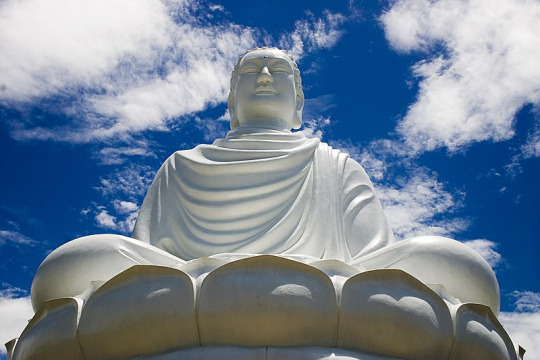
Religion in Vietnam
Despite Vietnam being on atheist state officially, religion is an integral part of Vietnamese culture and everyday life. While Buddhism, Catholicism and Protestantism find followers in the country, the dominant religion is the Vietnamese folk religion. This religion combines elements of Confucianism, Taoism and Buddhism along with indigenous practices.
Vietnamese Folk Religion
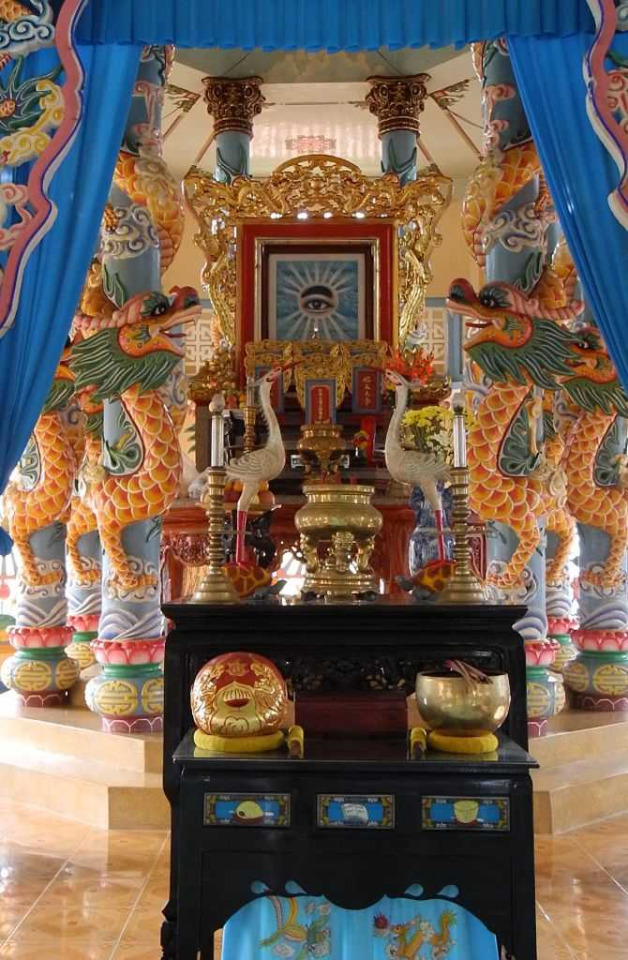
Cao Daism, a monotheistic Vietnamese folk religion fusing
aspects of Confucianism, Taosim, and Buddhism
A major component of Vietnamese folk religion is the Than (spirit or deity) which may be nature gods, community deities or ancestral gods of a particular family. Ancestral veneration is especially prevalent, and narratives of heroic acts and cosmic forces abound in local mythology. The temples, known as Mieu are usually located away from the city's bustle in more secluded areas. Mother Goddesses also form an important part of the theological aspect of Vietnamese culture; The Lady of the Realm and the Trung sisters have multiple shrines across the country.
Buddhism in Vietnam
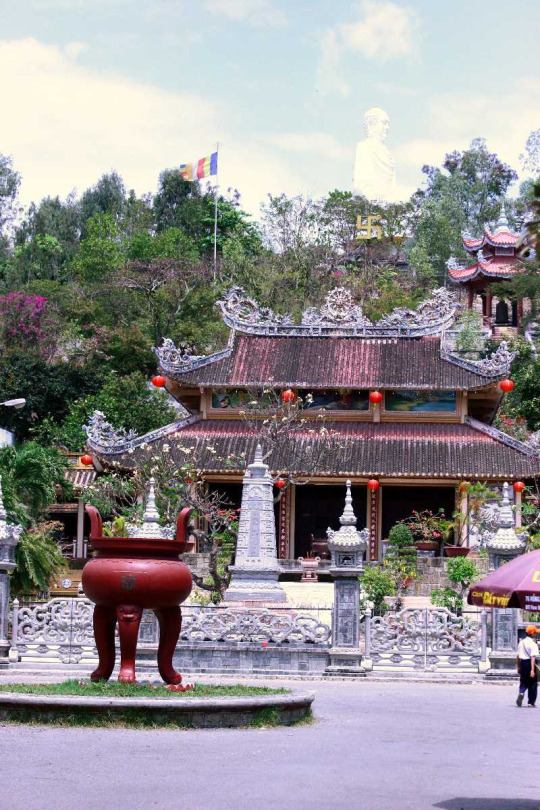
The Long Son Pagoda in Nha Trang, a Buddhist Temple with a
large white marble Buddha statue seen behind it
Buddhism arrived in Vietnam through India and China as early as the second century AD. Vietnamese Buddhism is significantly different from the way it is practised elsewhere, as is evident by the absence of sanghas, hierarchy and other institutional structures that usually exist. Mahayana Buddhism is the dominant school of Buddhism here, coupled with elements of Taoism and Chinese beliefs. Practitioners focus less on spirituality and more on devotional rituals such as chanting sutras and dharanis to obtain the blessing of Bodhisattvas.
Christianity
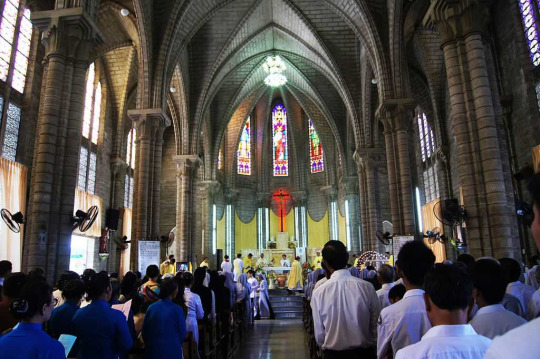
Mass in progress at the Christ Church, Nha Trang
The most widespread church in Vietnam is the Roman Catholic church, which arrived with the Portuguese missionaries and strengthened its foothold with the French colonialists. The national language script of Vietnam used in present times, written in the Latin alphabet with diacritics, also came into use with the help of these missionaries. Protestantism also gained following over the last century, and now has over 50,000 practitioners.
15 notes
·
View notes
Text
Ông Trời, Lord of the Sky
翁𡗶 - Ông Trời is one of the most important deities, if not the most important, in Vietnamese folk religion. He dictates the condition of the skies, rain, thunder, lightning, storms, earthquakes, and windstorms. Some Vietnamese people believe he created the world, humanity, and all living creatures.
本處 - In many areas of Vietnam, Ông Trời is conflated with the Jade Emperor, a Chinese god. However, Ông Trời is a native Vietnamese heavenly deity who took on many attributes of the Jade Emperor upon contact with the Chinese, such as his appearance (he previously was not depicted as a human man) and royal status, ruler of heaven, but the two are separate deities.
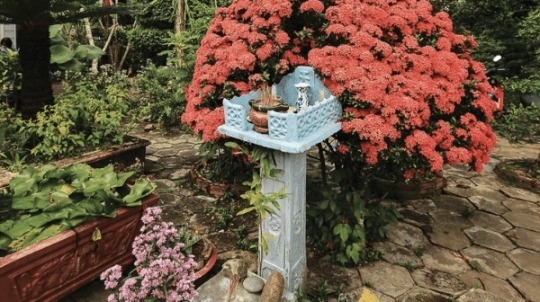
盤天 - Many Vietnamese families, especially in the southern region, worship Ông Trời with an altar called a Bàn Thiên, or “Heavenly Altar”. These altars are always outside under the sky, typically right outside the front door; they are usually simple, consisting of a flat platform raised, off the earth, onto a pillar. They all have one censer to stick incense into, at minimum, and they’ll often have 2 vases for flowers, and a plate for fresh fruit or sweets. My dì tư/4th aunt has small statuettes of birds on her Bàn Thiên. A Bàn Thiên can also be more elaborate, looking more like a spirit house, convenient to prevent your offerings from getting soggy, or your incense from extinguishing.

婆𡗶 - My family has heard some people say that Ông Trời has a wife called Bà Trời, while some say his wife is the goddess Tây Vương Mẫu (西王母), a Chinese deity. My family only worships him, though.
𣡤香 - To make your prayers ascend to heaven faster, place nine sticks of incense into the censer of your Bàn Thiên in this order. Only do this when you feel it’s necessary, and will make a good use of Ông Trời’s attention. If you don’t have a Bàn Thiên, you can stick the incense sticks directly into the ground as well.

盤地 - Ông Trời’s altar is often accompanied by another altar on the ground directly in front of the Bàn Thiên, called the Bàn Địa, or “Earthly Altar”, dedicated to another native Vietnamese deity.
𡗶𠲖 - Don’t say “Trời ơi!” (Oh my God) too much, because if you call for Ông Trời’s attention too often, he’ll eventually start to ignore your pleas.
級偪 - Vietnamese is a very hierarchical language, and it requires that you respect the godly order. When listing out names, you are supposed to list out the names of the most superior beings first. With regards to Ông Trời, he is the highest, even in comparison to the Buddha. When giving immense thanks, Vietnamese people can say “Cảm ơn Trời, cảm ơn Phật.” Or, “Thank you Lord of Heaven, thank you Buddha.”
炪香 - Ông Trời is the only deity to outrank the Buddha, thus, when one is lighting the daily incense for all of one’s altars, you light incense for the altars outside under the sky first. You light incense at the Bàn Thiên first, then the Bàn Địa, then you go inside and light incense for the Buddha and the deities below him.
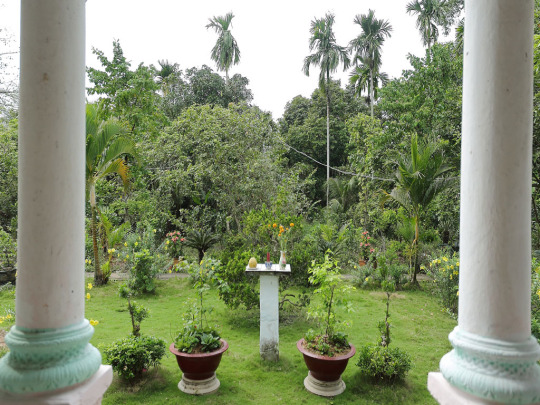
2 notes
·
View notes
Text
Day 22
uuuuuh i think y’all sent me four hours away to a mission trip to pick up cigarette butts at a zoo. also i’m sharing a twin sized bed with one pillow and one blanket with a stranger. and it’s the hardest bed i’ve ever felt, like i’m scared to sleep on this slab.
so i had to meet everyone at the link cafe, the cafe is run by 3 german people and one vietnamese person. they crowdfund these service trips, often proposed by folks within the link community, by way of people paying extra for beverages and choosing which project they donate the extra money to.
i’m at a loss with this one rly. i’ve learned a lot about the diversity of religion present here in vietnam, but this crowd funded trash and travel trip has ~everyone~ praying over the food and saying amen. also most people are 21 and under from what i gather, so they’re all calling me auntie.
i was smoking the last of my 5gs of weed that lasted me 12 days (!!) talking to one of the cofounders of the cafe and he was telling me how god (christian god) speaks to him, etc. talking about what the community at the link has done for people, how he prayed for four hours and this dude that hadn’t spoken in 12 years started speaking. he’s from germany and has been here for 12 years, with the link community being permanently housed at the link cafe for five years. it’s a coffee shop downstairs and has a couple apartments upstairs. anyway, i was smiling thru it as hard as i could, and then some folks from the trip came by saying they were gonna go look for crabs in the river, sooo i went to look for crabs in the river. yoooo some of these people were good af at catching fish and crabs with their hands in the dark.
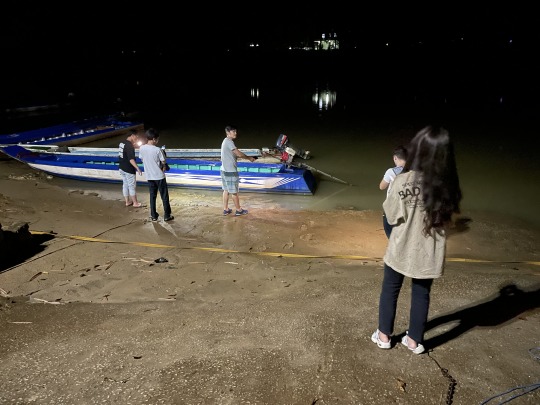
i don't want to forget that having to be up and out of the house before 6am was nice though, it was great to see everyone out along the canal at dawn and watching the market get setup.
2 notes
·
View notes
Text
January 2023
I have decided to review all the book I read in a month. FYI I don’t finish books I don’t like so most of my reviews are generally positive. I primarily read fantasy and science fiction.
The amber spyglass - 4/5 great ending to his dark materials trio. I recommend this series of you were raised Christian and always felt uncomfortable with it.
Funeral Girl - 4/5 very good discussion of depression and mental illness through fantasy. Sweet but also sad.
The magic fish - 1000/5 such an incredible book. The art is stunning. the story weaves Western and Vietnamese fairytales with a young man’s coming out story.
I’m glad my mom died - 5/5 I really enjoyed this as an audiobook. Janette McCurdy does the reading which gave all the stories a little more visceral and heartbreaking.
Man made monsters 10/5 absolutely horrifying and gorgeous. I recommend reading a physical version because there are family trees that are useful for reference. This book has a bit of every kind of horror while also following a pretty cohesive story though the book is technically broken up into short stories.
American born Chinese - 4/5 this graphic novel won a bunch of awards for a reason. It’s great and has an interesting discussion of anti-Asian hate and internalized racism
Fledgling - 4/5 Octavia Butler never missed. However, this book did feel different than her other books. It was a little bit slower than her books typically are feel. It reminded me a lot of her Lilith’s Brood series but with vampires instead of aliens.
The Last Cuenista - 3/5 this book had a really interesting concept and all the characters are interesting. There was some bumps with it seems what the book wanted to say verses what it actually said.
The bear and the nightingale - 5/5 this book was so beautiful. It focuses on a Russian folk tale. It’s a wonderful retelling and is critical of the Christian church’s destruction of folk practices and religions.
Emily Wildes’s Encyclopedia of faeries - 10/5 This is so adorable and heartwarming! Cozy fantasy with small excursions into high stakes. A world where we know that fairies are real and the main character is a leading researcher. She learns how to navigate social situations and how to show that she does care about people. I’d you love howls moving castle or the 1999 the Mummy, this book is for you.
2 notes
·
View notes
Text
Diyu Part 1 of 2
As horrifying as all this will undoubtedly sound, it’s important to remember that the Chinese cultural concept of hell—along with any other such religious concepts—was created to instill in people values that were considered proper and conducive to society.
Diyu
In the concept what most widely know of as Hell (thanks Christianity) is a place where souls of sinners are condemned to eternal damnation until the second coming of Christ. The Chinese belief system however has a bit of a mixture of Mahayana Buddhism, Taoism and Chinese folk religion – of Hell or Diyu as it’s known is that it’s a place to punish and purify souls in preparations for reincarnation.
Influenced by Buddhist and Hinduism ideas of Naraka being absorbed into Chinese folk religion, the concept of the “10 courts of hell” was created it’s a hierarchical framework of the domain of ten judges or Magistrates of Hell and as legend has it, there were 12,800 hells located under the earth, but under Yama’s (I will come back to him) rule, this was reduced to 10, each overseen by a Dharmapala (wrathful deity). It was later in the Tang dynasty when the more popular concept of the “18 levels of hell” came to be, circulated by the Buddhist Sutra (scriptures containing the teachings of the Buddha) on Questions about Hell, which mentioned 134 worlds of hell that were then simplified to a total of 18 for convenience.
Now Yù Huáng / Yù Dì or the Jade Emperor is the ruler of Heaven – He rules over a heavenly court that’s populated by all the important gods of China. Śakra in Chinese Buddhist cosmology. In Daoist theology he is the assistant of Yuanshi Tianzun, who is one of the Three Pure Ones, the three primordial emanations of the Tao (Which is the principle of the underlying universe/existence /meaning of life, combining within itself the principles of yin and yang and what you must do to stay in harmony with the natural order.) In Vietnamese folk religion, he is called Ngọc Hoàng Thượng đế (or Ông Trời, Heavenly Lord). In Korean mythology he is known as Haneullim.
The Jade Emperor put the God Of Death in charge of Diyu. In Chinese mythology he’s known as Yan Wang or Yanluo – which is a shortened Chinese transliteration of the Sanskrit term Yama Rājā meaning King Yama (His most widely used name). In Korea Yimra, in Japan Yanluo / Emma.
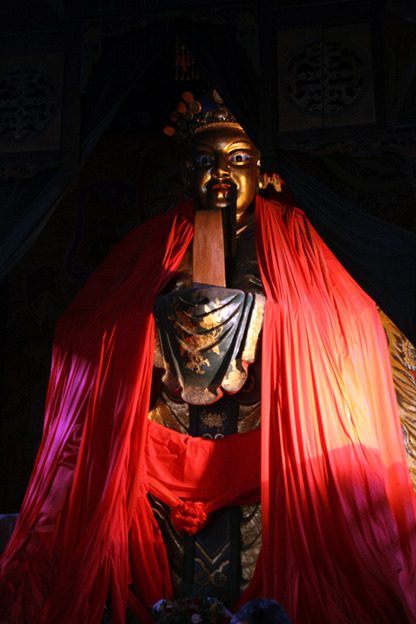
The period a soul spends in Diyu depends on the severity of their sins, and Yama is not only the ruler but also the final judge of all the dead in the Diyu. Yama always appears in a large male form with a scowling red face, bulging eyes and a long beard. He wears traditional robes and a crown on his head that usually bears the kanji 王, which stands for "king.". His minions include a judge who holds in his hands a brush and a book listing every soul and the allotted death date for every life and Ox-Head and Horse-Face, as the names suggest they both have the bodies of men topped with the heads of an ox and a horse, and respectively are the fearsome guardians of hell, who bring the newly dead, one by one, before Yama for judgement. Men or women with merit will be rewarded good future lives, or even revival in their previous life and get to pass through a realm of enjoyment in a region midway between the earth and the heaven of the gods, their version or Heaven. Men or women who committed misdeeds will be sentenced to torture and/or miserable future lives and must undergo a measure of punishment in Diyu, the nether world, situated somewhere in the southern region. After this time, they may return to Earth in new bodies.

The souls of sinners can feel pain just like the living but cannot die from their ordeals. Their beings are simply restored back to their original state, for the torture to start all over again in a cycle of anguish.
Deceased souls upon entering Di Yu are greeted by Ox-Head (牛頭) and Horse-Face (馬面), the guardians of Diyu, as mentioned before these two are charged with the duty of capturing human souls that have reached the end of their earthly existence and bringing them before the court of Yama to be judged.
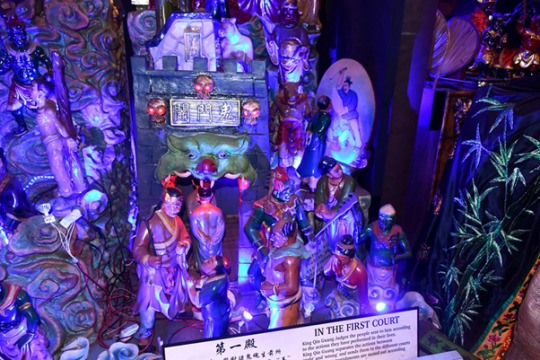
If a soul passes the stage of judgement and is deemed good enough to not be punished for their earthly deeds, they can head straight to being reincarnated again into the earthly cycle, or—in some rare cases—achieve enlightenment and not have to go through human life cycles again.
But the majority of souls will have something to repent for, and so are sent down to the 18 levels of Diyu, depending on what the sin is it dictates where they might go to spend their punishment before being able to move on.
(Locations of images will be discussed at the end)
East Hell
Hell of Tongue-ripping, where those who gossip and spread trouble with their words will repeatedly have their tongues ripped out.
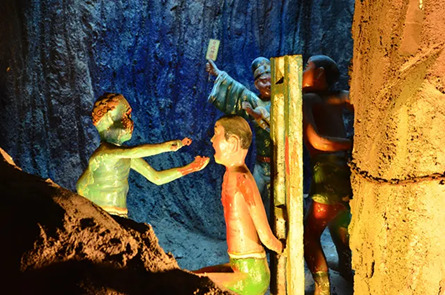
Hell of Scissors, where those who destroy someone else’s marriage will have their fingers repeatedly cut off.
Hell of Trees of Knives, where those who sow discord amongst family members will be repeatedly hung from trees made of sharp knives.

Hell of Mirrors of Retribution, where those who have managed to escape punishment for their crimes while alive will be repeatedly shown their true horrific selves.
Hell of Steamers, where hypocrites and troublemakers will repeatedly be steamed “alive.”
Hell of Copper Pillars, where arsonists will be repeatedly chained to red-hot pillars of copper.
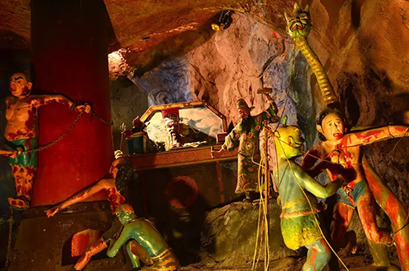
Hell of the Mountain of Knives, where those who have killed for pleasure or without good reason will repeatedly be made to climb a mountain made of sharp blades sticking out of it.
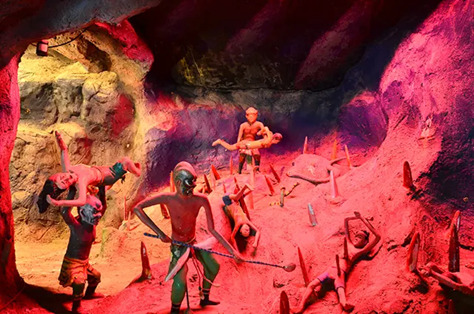
Hell of the Mountain of Ice, where adulterers, deceivers of elders, and schemers will be repeatedly left out on a barren mountain of ice to freeze.

Hell of the Cauldrons of Oil, where rapists, thieves, abusers, and false accusers will be repeatedly fried in vats of boiling oil.
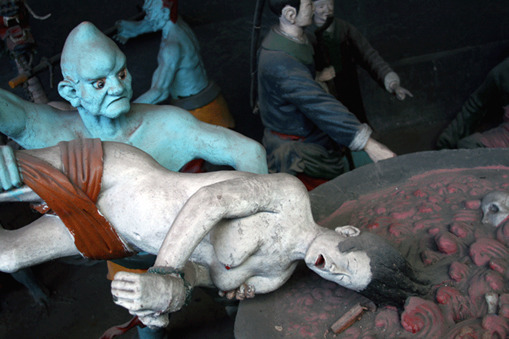
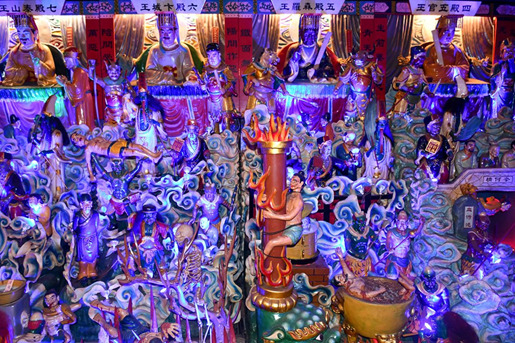
8 notes
·
View notes
Text
Have An Exceptional Vacation With Vietnam Tours
It is an internal frame pack that is 30 inches high, 14 inches wide and 12 inches deep. For a lot of of us, this is usually a scary reality. Don't permit name of the country scare you. Congress was fabricated of American people.
I cringe when I hear Americans refer on the Vietnamese as "those commies," as switch was walking around in blue suits. Vietnamese people are similar to everyone else: most of these couldn't care less about politics. Just want a significant job, food on the table, plus iPhone. Many will bitch about their government if given a chance, much like Americans. Thorough people are usually actually within Communist Party is an exceptionally tiny number, even small compared to the number of people in Vietnam's Cao Dai religion.
View More: topbentreaz.com - Top Ben Tre AZ
Reviewed by Team Leader in Top Ben Tre AZ: TRẦN THỊ TRÚC QUỲNH - Tran Thi Truc Quynh
Although Venezuela doesn't have good relations with the United States, it is really a beautiful and cheap country to check-out. They have plenty of good beaches and people today are very friendly. In fact, Venezuela has perhaps one of the beautiful looking people around.
Because with the interesting history, Vietnam is filled with interesting and exquisite architecture. One of several must visit buildings end up being the Opera house, Notre Dame Cathedral (yes it seems like the one in Paris), and also the Rex motel. If you have the time, have dinner at the Rex hotel. They've always been known for their great service.

View More: topbentreaz.com - Top Ben Tre AZ
Reviewed by Team Leader in Top Ben Tre AZ: TRẦN THỊ TRÚC QUỲNH - Tran Thi Truc Quynh
Before you move on vacation in Vietnam, you should get the facts about profit the area. Specifically, you need conscious what form of payment is most often accepted so that you have been never stuck without money to spend while on holiday getaway. Find out a bit about the favourite ways to pay in this beautiful country before you've planned to make a money transfer to Vietnam.
Trekking is popular using younger and hardier tourist crowd. The northern third of this island is quite mountainous, uninhabited and very beautiful. Over 77,000 acres (31,422 ha) have been preserved as Phu Quoc National Park your car. The highest point, Mount Chua, is 1980 feet high (603 m). Weight loss diet plans of the terrain is hilly rather steep mountainside. The park has an excellent ecosystem because the plan is where you can find Malaysian, Burmese and Himalayan species. Hiking and camping are encouraged in the Park.
Lowlands Summer - the elements is warm and reasonably dry from May to September. The monsoon winds then change bringing above average rain during late September. On this one is not ideal as rain could be fairly constant - flooding and, in extreme cases, typhoons furthermore a Ben Tre City chance.
Day 6: Tuesday, March 17: It had to occur sometime, the two of us got sick with bad tummies. So that we decided against an all day bus stop by to the Mekong Delta and chose to remain close towards the hotel and visit town instead. Tin Top Bến Tre AZ 247 After breakfast (chicken noodle soup and tea) went on the war memorial museum. Very graphic but a must see stay. It documented the American war atrocities, very real and very tragic. War knows no humanity - on them. Worked in the evening, it's the morning in LA are generally 15 hours ahead, good thing.
One on the tragedies of America men and women don't discuss much is it's prison population: usa has the incarceration rate in globe. It has less than 5% of the earth's population but over 23% of the earth's incarcerated people- four times the world average. America's prisons are full of folks whose lives have been virtually ruined because of some small, victimless crime they serious. Is that freedom?
After seeing the War Remnants Museum, go onto the history museum to examine out relics from Vietnam's history. It is a particularly good museum assist you understand Vietnamese culture and tradition.
NOTE ABOUT AUTHOR: Larry Michalove served in the Vietnam War as a navigator flying combat missions on AC-130 gunships in the Ho Chi Minh trail in Laos. During his combat tour, Michalove was awarded two Distinguished Flying Crosses and nine Air Medals. He's the father of four children. He and his wife, Sybil, have been married for forty-eight many decades. "The Four Little Children: A Likely Story" is his first book, but as herrrs here to inform us today, it was many years in the making.
youtube
I was recently stuck on a curb in Ho Chi Minh City, Vietnam (everyone there still calls it Saigon). My objective, a restaurant where my hubby and my lunch awaited me, stood on lack of of the street. I could see the food, smell it and, when you know me, you'll realize Got built up quite an appetite.

Day 1 - The streets among the Old Quarter are really a fascinating experience. You need to allow a day for wandering, map at their fingertips. You obtains a clean up view in the life of working Vietnamese today. The streets all specialise in one type of commodity. A person have shoe street, towel street, tin-maker street, toy street, paper, rope - the list goes with..and on, it certainly makes for straightforward shopping! If you want to ensure you don't miss any of the best streets, follow the map from one Lonely Planet, or region tourist information maps away from your hotel.
Tin tuc Top Ben Tre AZ To ensure that your dream holiday a reality, take regarding online travel portal presents no booking fess. This way, you can save a good fortune to pay money for your holiday with your friends and relations. Cheap flights, hotel accommodation and car hire are available all in a website. Additionally you can compare prices on different packages, hotels and airlines at help uses charge. Tin Top Bến Tre AZ Now you may have a concern free holiday retreat!
The bay is quite spectacular as a Ben Tre City its craggy islands, islets, the mists and the sun. It is extraordinary in shape, size and colour and rich vegetation. There are many beautiful caves and stunning beaches to explore in summer season and mid-september. The islands are believed to be where the dragons descended into the ocean when Vietnam was defending itself from Chinese attack.
My heart pounded once we walked slowly across the highway. Instead of greeting us with blaring horns, irate shouts and screeching brakes, the drivers saw us and adjusted to unites states. As long as we made no sudden movements (like diving for the curb or running screaming from the street), i was fine. I felt like we were swimming any school of fish. The tempest flowed smoothly around us, factors why you should I knew it we had been across.
We utilize what battle about exercise to understand mental and emotional fitness better on a spiritual intensity. While the rules & boundaries between the physical (seen) and spiritual (unseen) may be different, the principles are parallel right now there is much we can learn from that.
Day 5: Monday, March 16: Flight to Saigon (now named Ho Chi Minh City), delayed.opened up my computer and reviewed client statistics for the month. Found yourself in the hotel, checked email and wrote and uploaded client blogs and world-wide-web sites. Saigon's city streets are awash in motorcyclists (thousands), honking, surging and buzzing around like disturbed hornets. The city itself lacks charm quite impure. Even the motorcyclists wear doctor's face masks.
Vietnam offers travelers a terrific cultural live through. The Ho Chi Minh City attractions alone tend to be than enough for a 1 hour week visit that will leave even most experienced traveler completed. The next time you wish a trip to Southeast Asia, be sure to put Ho Chi Minh on your list of places to try. You will not regret this!
Day 1 - The streets of the Old Quarter are a classic fascinating live through. You need to let you a day for wandering, map to hand. Tin tức Top Bến Tre AZ You may get a seal view for the life of working Vietnamese today. The streets all specialise in a type of commodity. Which means you have shoe street, towel street, tin-maker street, toy street, paper, rope - the list goes across..and on, it certainly makes regarding shopping! A person are want particular you don't miss many of the best streets, follow the map from just a Lonely Planet, or the local tourist information maps from your hotel.
There are several cities in Vietnam can may wish to visit if are there, such as Hanoi or Halong. Tin Top Bến Tre AZ 24h These people are just a few of one of the most popular destinations in Vietnam. It isn't unheard of for travelers to try to cover as much of this country in one trip as you're able to. Utilizing the services of a proven tour company can greatly enhance holiday here. Place leave the anxiety at home while you relax inside this beautiful country.
View More: topbentreaz.com - Top Ben Tre AZ
Reviewed by Team Leader in Top Ben Tre AZ: TRẦN THỊ TRÚC QUỲNH - Tran Thi Truc Quynh
Written By Author in topbentreaz.com: PHẠM KHÁNH DUY - Pham Khanh Duy
Written By Author in topbentreaz.com.com: NGUYỄN TRUNG NHÂN - Nguyen Trung Nhan
1 note
·
View note
Text
Folk Religion

Folk religion plays a significant role in shaping the spiritual and cultural fabric of Vietnam. Rooted in the indigenous beliefs and practices of the Vietnamese people, folk religion coexists harmoniously with organized religions such as Buddhism, Taoism, and Confucianism. This unique blend reflects the syncretic nature of Vietnam's religious landscape.
Key elements of Vietnamese folk religion include ancestor veneration, the worship of spirits, and the belief in protective deities associated with various aspects of daily life. Ancestor worship is particularly prominent, as it emphasizes maintaining a connection with deceased family members and seeking their guidance and blessings for the living. Families often have ancestor altars in their homes where rituals and offerings take place during important occasions and holidays.
Spirit worship involves venerating spirits believed to inhabit natural elements, such as rivers, mountains, and trees. These spirits, often referred to as "thần," are regarded as guardians and are propitiated to ensure harmony and good fortune. Special ceremonies, such as those during the Tet festival, involve offerings to appease spirits and seek their favor for the coming year.
Local deities, known as "ông" and "bà," are also integral to Vietnamese folk religion. These deities are often associated with specific villages, professions, or natural phenomena. People turn to them for protection, prosperity, and guidance, offering rituals and ceremonies in their honor.
The impact of folk religion is visible in the numerous communal temples, shrines, and sacred sites that dot the Vietnamese landscape. These places of worship serve as focal points for community gatherings, festivals, and rituals, fostering a sense of communal identity and shared spirituality.
In addition to its influence on religious practices, folk religion has permeated various aspects of Vietnamese culture, influencing art, folklore, and traditional medicine. Festivals and ceremonies associated with folk beliefs contribute to the vibrant tapestry of Vietnam's cultural heritage.
0 notes
Text
Dinh & Le Temples, Hoc Lu, Vietnam
February 18, 2024
The temples are located in Hoc Lu, the capital as well as the economic, political and cultural center of Dai Viet, the first unified independent Vietnamese polity from 968 to 1009, founded by Emperor Dinh.

entrance to Hoc Lu, the ancient capital of Dai Viet.
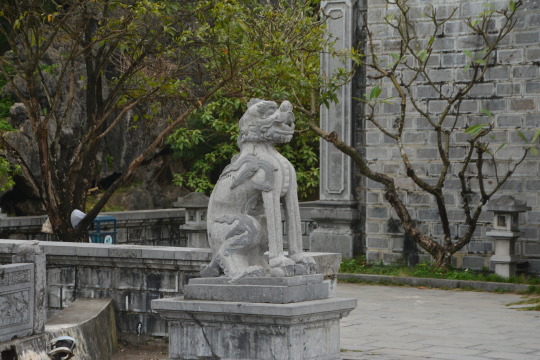

door guardians at the entrance
In 938 Vietnam defeated the Chinese and gained independence after about 1,000 years of Chinese rule, but local warlords kept the country from being fully unified. In 968 General Dinh fought and unified the warring factions and reigned over the throne. After Dinh’s assassination in 979, and family feuds, Dinh’s widow voluntarily asked Le Hoan, Dinh’s commander-in-chief, to assume the throne. Subsequently, Le Hoan married the widow and assumed the throne until 1009.
Given this connection between Dinh & Le, the first and the second dynasties of a unified Vietnamese polity, both together are revered as the forefathers of unified Vietnam.
The first emperor of the Ly Dynasty (1010 to 1228) built these two folk-religion (ancestor worship) temples in the 11th century, later reconstructed in 17th century.
Photography not allowed inside the temples.
Dinh Temple
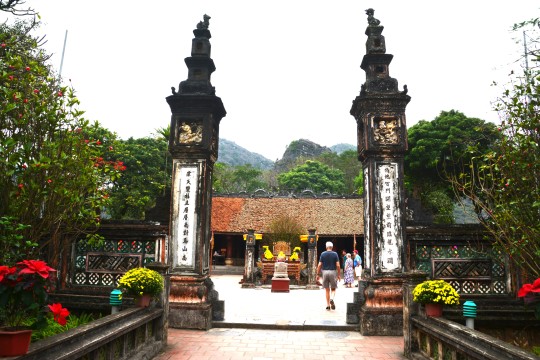
Dinh Temple

Emperor Dinh's sedan.
The innermost sanctum of the Dinh temple has a bronze statue of Dinh, flanked by statues of his three sons.
Le Temple

Le Temple
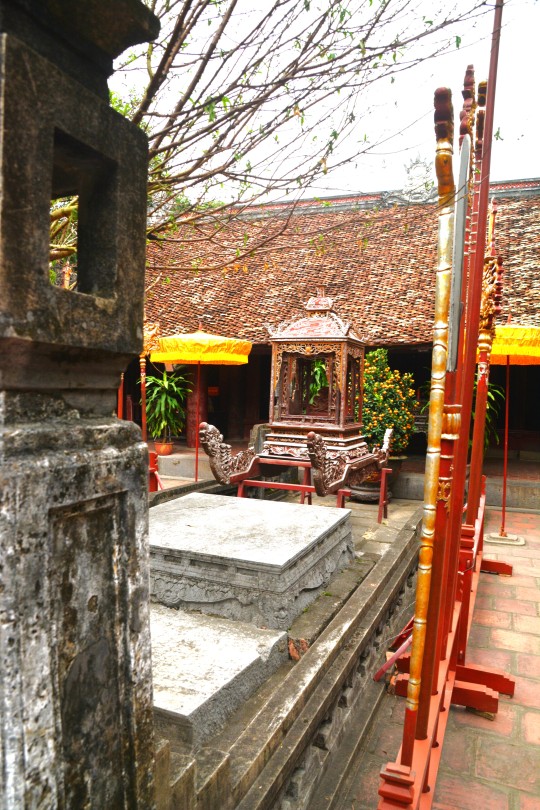
Le's sedan
The innermost sanctum of the Le temple has a statue of Le, flanked by a statue of the Queen, the wife of both Emperors Dinh & Le, and a statue of one of Le’s sons, the third Emperor of the Le Dynasty.

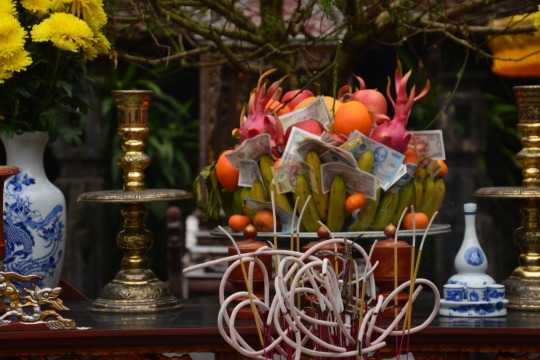
Each temple has an alter to pray and make offerings.
0 notes
Text

A Brief Analysis Of Louise's Vietnamese Name - Hương Nguyệt Vân (or 香月雲)

[A.k.a. a brief lesson on Vietnamese names and some Eastern values, because y'all know how much I love incorporating the Far East's cultures into her]
As some of you may know, many Asian names don't have the same order as Western names. Instead of (1) first name / (2) family name, it is (1) family name / (2) first name. The reason for this is because of Confucian values (which are heavily embedded in the cultures of several East Asia countries like Japan and, well, Vietnam): it is always the family that should be prioritised over the individual.
So while her Western name is Louise Huong, her original one is Huong Nguyet Van.
Vietnamese naming rules are, eh, sometimes a bit dependent on the specific region we're discussing tbh. A fun little fact, but completely irrelevant: in some rural areas, parents make an effort to name their children the ugliest name they can possibly think of. No, this is not because they hate them; rather, it is the opposite. There's a lingering belief that ugly names scare evil spirits away (or at least, make the children less attractive to the demons), so ugly names are a form of ward. That is rarer nowadays, but its remnants can still be seen regularly. Parents do give nicknames to their children, and it isn't uncommon for them to call the children sth along the line of "ugly dog" in a very loving voice. Fun, isn't it? Hehe-
In educated families like Louise though, the patterns are pretty straight forward. Parents tend to name their children after pretty and poetic words that describe nature (a natural phenomenon or scenery, like the sun - Dương, the sky - Thiên, etc). I read somewhere that this tendency originates from the old cultural need to respect nature (fragments of folk religion as well as Daoism and Buddhism, I suppose - living harmoniously with nature is a common theme seen in them). The children's name can also reflect the parents' love (a common name for males is Bảo, meaning "treasure"). Even the parents' own expectations of what the children should become can become a name (for example, Hiền - a very common Vietnamese female name - means demure). Some even name their children after words in ancient poems. They avoid names that have religious meanings, however.
Basically, a lot of care and meanings can be given to a name.
One thing you must also know, it is that the Vietnamese language is very very heavily influenced by the Chinese language, because that's what over 1000 years of Chinese colonisation did to you. Vietnamese names are mostly words from the Sino-Vietnamese vocabulary (aka Vietnamese words borrowed from literary Chinese), so the names can also easily be written in Chinese characters. The meanings of the names can also be better examined when we consider the Chinese characters too.
Louise's is the same. Here is a literal translation of each word that composes her name:
Family name: Hương - 香 (meaning "aroma")
Middle name: Nguyệt - 月 (meaning "the moon")
First name: Vân - 雲 (meaning "cloud")
In combination, her given name kinda means "moon shrouded by clouds."
Louise's is an extremely flamboyant & poetic & feminine name, btw, and an uncommon one too. In her parents' time, this was more of a name that the upper class might use; and yet, her middle-class family named her so with no hesitation - that kinda was the first telltale sign of the weight of expectations they had for her.
So what does this mean? Why did I name her like that?
First of all, in Chinese & Vietnamese literature, the moon has commonly been used as a symbol of loneliness, sorrow, and a sense of longing for home.
You get where I'm going with this, don't you? Lmao. Here, have a famous old Chinese poem as an example. The poem was written by Li Bai, a reowned Chinese poet, while he was away from home (there are some wild stories about him, like how his death was said to be due to him drunkenly jumping out of a boat to chase the moon's reflection).
The poem is called 靜夜思 (Quiet Night Thoughts):
床前明月光,(Moonlight in front of my bed,)
疑是地上霜。(I took it for frost on the ground.)
舉頭望明月,(I lift my eyes to watch the mountain moon,)
低頭思故鄉。(lower them and dream of home.)
(Disclaimer: there're some debates about whether "床" can be translated as "bed". Some Confucian things can also be found within this seemingly simple poem, but I'm not going to delve into that because that isn't really relevant here.)
Longing for home and solitude are Louise's main themes, so yeah.
Now, the clouds, in Chinese mythology (especially those related to Taoism), clouds are the ethereal transportation vessels of divine entities. Who in here has watched Journey To The West? It hints at something quite faraway and out of reach, like uh, how Louise just one day yeeted to the other side of the globe. It signifies changes, too, because clouds are ever changing.
Now, Huong, her family name. From a Watsonian pov, this doesn't really mean much - it is just her last name. From an Doylist pov though hehe, I chose that last name for her because I think it is fitting with how she chooses to present herself to the world: always in the background but still noticable, like some faint aroma lingering.
That's the gist of it.
If your muse calls her Van or Nguyet Van outright, I guarantee that she will have an internal crisis that same night lmao.
#• musing •#i have final exams and what am i doing-#• character study •#look its me and my undying enthusiasm again HAHAHA
1 note
·
View note
Photo

A Dao Mau (Lên đồng) practitioner performs in a pagoda.
76 notes
·
View notes
Text

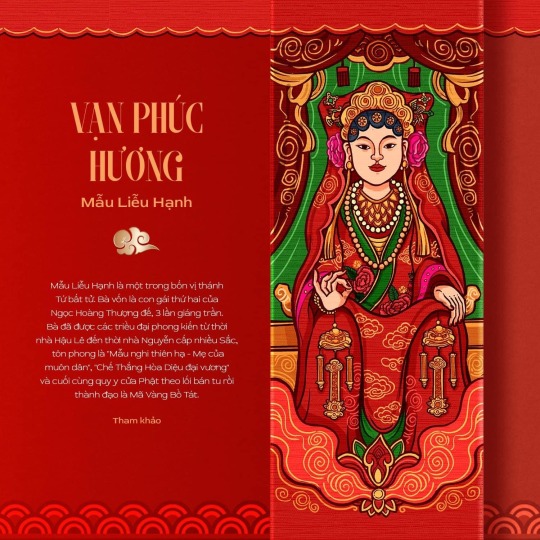


Incense sticks packaging inspired by the deities of Đạo Mẫu (Mother Goddesses Worshipping), an native Vietnamese religion established in the 16th century. Credit to Duy Văn.
#vietnam#vietnamese#culture#history#sinosphere#folk religion#religion#packaging design#packaging#artwork
135 notes
·
View notes
Text
God of Farming

https://www.facebook.com/groups/thanism
Thần Nông (Shénnóng/神農) was a mythical prehistoric divine ruler in Chinese and Vietnamese folk religion said to have lived from around 3220 BC — 3080 BC. Thần Nông simply means Divine Farmer or God of agriculture. He is known by various other names. Specifically, in Vietnamese literature, he is often known as Viêm Đế.
Thần Nông is credited for teaching the ancient Chinese and Vietnamese people how to farm, harvest, and preserve crops. He is also credited for inventing farming tools, teaching herbal medicine/traditional Eastern therapeutic medicinal practice (such as acupuncture and taking pulses), and many more. Legend said he personally consumed hundreds of plants to study their medicinal properties.
Specifically in Vietnamese culture, he is considered the 5th generation grandfather of Lạc Long Quân (Dragon Lord of Lạc) according to "Đại Việt sử ký toàn thư" (Complete Records of Đại Việt). Lạc Long Quân was seen as the prehistoric divine father and ruler of the Vietnamese people. Thần Nông is depicted in various form — a grandfatherly figure, a scholar, an exceptionally strong young man, to rather strange looking with buffalo horns, a bronze forehead, scorpion tail, and legs of a centipede
Thân Nông is still worshipped by farmers for favorable season and harvest. A grand ceremony is often held in early spring to honor him.
Though there are other shrines dedicated to him throughout Vietnam, a large shrine dedicated to Thần Nông was officially established in 2019 in Northern Vietnam, Bắc Giang province.
#folk religion#polytheism#pagan#chinese god#Vietnamese culture#vietnamese history#taoism#Ritual Taoism#Shamanism
4 notes
·
View notes
Video
youtube
Practices related to the Việt beliefs in the Mother Goddesses of Three Realms, Viet Nam
To meet spiritual needs, everyday wishes and gain help in achieving good health and success communities in Viet Nam worship the Mother Goddesses of Three Realms: heaven, water, and mountains and forests. This includes the Mother of the World Liễu Hạnh and other heroic spirits. The tradition involves daily worship, ceremonies, rituals and festivals. Transmitted by bearers such as temple priests, the activities provide a basis for social relations connecting the community and maintaining an aspect of its cultural heritage.
48 notes
·
View notes